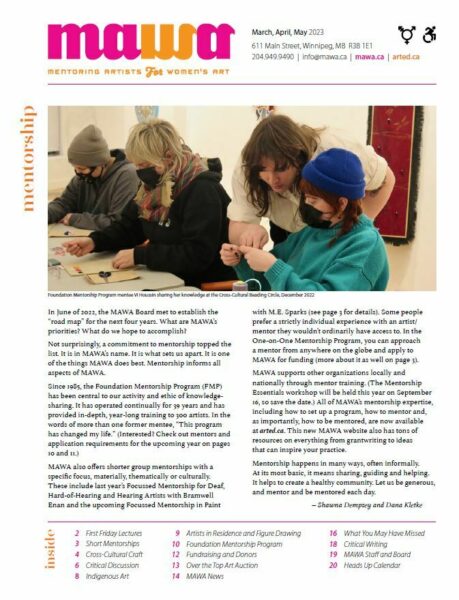
Liz Barron
Recently, I was asked to assist an Indigenous not-for-profit with their Executive Director search. At the same time, there was another major arts organization also searching for an Executive Director. Both are seeking a qualified candidate; they have created space for a mid-career arts administrator to step into the role. But where are they?
Funders have been providing mainstream arts and culture organizations with token funding to hire Indigenous, Black and Persons of Colour (IBPOC) within their organizations. These diversity funds allow organizations the financial contributions to hire IBPOC, often for the shorter term, without changing their internal culture. In 2021, the Manitoba Arts Council offered an Arts Leader program to support and develop IBPOC arts administrators within their own organization or collective, or the applicant could apply with an organization and a detailed mentorship plan. Ideally, the candidates that were successful would take those skills and apply them to their own practice or find employment within an institution in mid-career arts administration. However, organizations were not provided with additional operating funds to hire new staff. The Manitoba Arts Council received 32 applications to the new funding program, and there were seven successful applicants; of them one identified as Indigenous, three identified as Black and three identified as a person of colour. The impact of the funding for the successful applications won’t be known till they complete their leadership program, sometime in late 2023. After that funding comes to an end, where will the opportunities be for them?
Research indicates that “the leadership of major arts organizations in Canada does not reflect the diversity of Canada's population. For example, among 125 Canadian Arts Summit organizations, only 5.7% of CEOs are racialized compared to 94.3% who are white. The findings show similar results for lack of diversity in the Artistic Director and Chair of the Board roles.” [i] With only 5.7% of CEOs currently within an institution, how does an Indigenous-led not-for-profit recruit from among those cultural organizations?
In my thirty-plus years in the arts and cultural sector, I’ve been supported by amazing mentors I could ask for assistance and who modelled what their commitment to the arts looks like. Along the way, I also participated on boards of directors to learn, share and network. This was a choice I made to enhance my skill set within the arts. I worked for organizations that I needed to learn from (performing arts and publishing) and others that needed an Indigenous perspective. These two things—mentors and participation on boards—grew my knowledge, my network and my ability to secure contracts. Was I just lucky? Has it been easier in the past to find a mentor and to volunteer?
I started my career at Plug In, before it became an ICA, an institute of contemporary art. I was able to work with Kathleen Darby and Wayne Baerwaldt, who both offered me all the support I needed to be able to work in the arts. At that time, I met Louis Ogemah and Deb Prince, who asked me to join them in starting Urban Shaman, a contemporary art gallery for Indigenous artists. Without the mentorship with Kathleen and Wayne and the working knowledge I was able to acquire at Plug In, being able to start a new artist-run centre would have been inconceivable for me.
Their mentorship wasn’t a formal arrangement; working in the organization, watching them in action, and receiving their guidance provided me with the tools I needed to be successful. I also had a formal mentorship with Jim Carr, the former President and CEO of the Business Council of Manitoba, who assisted me with my writing and editing skills, knowledge of Manitoba Opera and Board governance.
Being an arts administrator is not as glamorous and engaging as being a curator or programmer for film festivals. Sure, we get that, but we also need administrators to make sure the curators and programmers have a budget to work with and artists can be paid, rent is paid and equipment is purchased. So how are they being developed today? I have been fortunate to mentor two Indigenous women emerging Executive Directors, one with an organization that has a history of exhibitions and one who is starting a new organization in her First Nation community. One mentorship is casual, “Call me when you need anything,” and involves reviewing grants, budgets and artist contracts. The other is more formal in terms of time commitments, and involves setting up Indigenous governance and membership criteria. Both models are working well.
Neither of the mentees I’m working with is ready for a major institution Executive Director position, and so they are not appropriate candidates for the organizations currently doing a search. I’ve reached out to several directors at various institutions and artist-run centres to ask if they have anyone they could recommend, and a few suggestions came up, but those were all of senior artists rather than arts administrators. Nothing wrong with an artist being an arts administrator, but being an Executive Director is a full-time, all-hours, all-day kind of position.
The challenge in moving forward is to find the emerging and mid-career arts administrators and ask if they are interested in a full-time career in arts administration and its responsibilities. Would they like a mentor? If so, we should encourage them to put a plan together and find someone to help guide them. I’m going to continue working with my two mentees as they need me, but I’m also going to investigate developing a mentorship program for mid-career arts administrators. Yes, there are certificate and degree programs available for Arts Administration, but we need to engage on a deeper, personal level to nurture those that are seeking careers in the sector.
Senior arts administrators need to look at ways to develop and encourage the next generation. It is clear that there are gaps, and how we manage those gaps can have a direct impact on how organizations can successfully manage their hiring practices. By adding the collective knowledge of senior administrators, we can effectively enhance the cultural landscape within the arts and grow organizations through successful succession planning. Take a look around, and take a chance. If you are a mid-career administrator, apply for those ED positions. Seek out a mentor. If you are an arts administrator that can provide guidance, step up. We need to hear new voices and bring forward the next generation.
Liz Barron is an independent media arts curator and culture connector, located on the homeland of the Métis and Treaty One Territory. She is one of three founding members of the Harbour Collective, which engages in research activities, artistic programming and service delivery for filmmakers, media artists and visual artists.
[i] Wall-Andrews, C., Wijesingha, R., Cukier, W. and Lightwala, O. (2022), “The state of diversity among leadership roles within Canada’s largest arts and cultural institutions,” Equality, Diversity and Inclusion, Vol. 41:9, pp. 30-46. https://doi.org/10.1108/EDI-02-2021-0054

